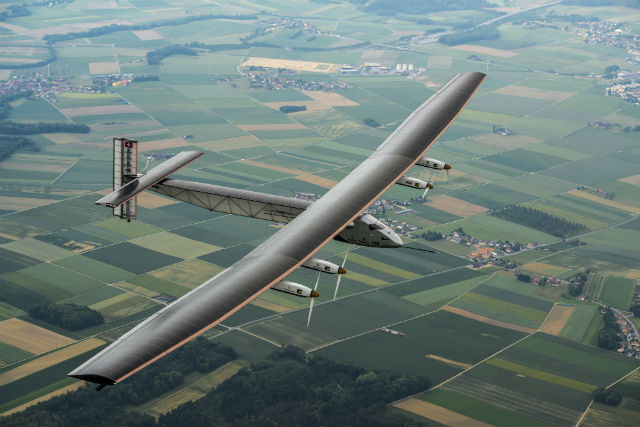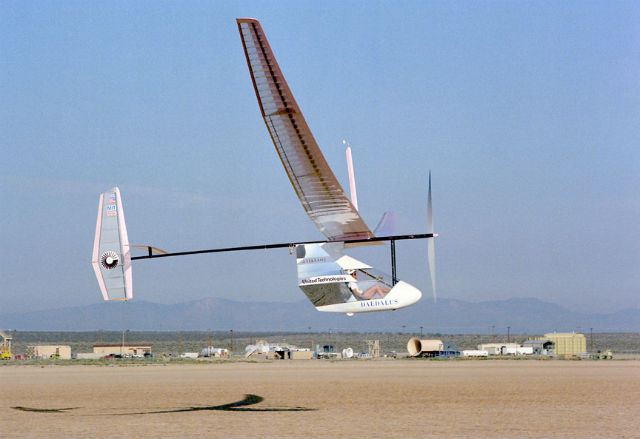As an aviation record-setting machine, Solar Impulse 2 is off to a good start. Following a relatively short first leg of its round-the-world adventure – 400km (249 miles) from Abu Dhabi to Muscat, Oman in just over 13hr, including a long holding pattern – stage 2 covered 1,468km in 13hr20min across the Arabian Sea to Ahmedabad in India, claiming the solar-powered world straight distance record for manned flight between pre-declared waypoints.
Subject to Fédération Aéronautique Internationale verification, the record will replace that set by SI2’s predecessor aircraft in 2013 – a flight of 1,386.5km made during a barnstorming tour of the USA that formed part of the preparation for the round-the-world flight.
Project co-founders André Borschberg and Bertrand Piccard – both accomplished aviators – must be pleased to be making a mark in the aviation history books. Borschberg was at the controls during the now-eclipsed record and for the Abu Dhabi-Muscat leg, while Piccard flew the crossing to India. Both of them will have a chance to push the endurance record further on upcoming legs across the Pacific and Atlantic oceans – their personal endurance will also be on test during those legs, which will take up to six days.
If all goes to plan and the 12-stage, 35,000km journey brings aircraft, Borschberg, Piccard and ground crew back to Abu Dhabi – possibly by mid-May – they will have achieved another first: girdling the globe in an aircraft powered exclusively by solar power. Technically, that “first” may remain up for grabs, as Solar Impulse 2’s route won’t take it across the equator. But by crossing the Middle East, India, China, two oceans, the USA and Europe, Borschberg and Piccard will have made their point.
That point – perhaps remarkably given the icon of this venture – is not about aviation: it is about energy. The pair hope that flying huge distances with no more power than is generated by a small motor scooter will demonstrate that the world’s formidable energy challenges can be met by existing technologies. So, they will be using their time – and the massive presence of their aircraft – during all their stops along the way to hold press conferences and meet with governments, non-governmental organisations, universities and schools. As Piccard puts it: “With our attempt to complete the first solar-powered round-the-world flight, we want to demonstrate that clean technology and renewable energy can achieve the impossible.
“Renewable energy can become an integral part of our lives, and together we can save our planet’s natural resources.”

Solar Impulse
As Piccard recently told Flight sister journal ICIS Chemical News: “The technological solutions that allow Solar Impulse to fly both day and night are accessible to all and are replicable in everyday life. These are not secret, futuristic technologies. If they were used routinely in our society, we would be able to save 50% of our consumption of fossil energies and to produce half of the rest with renewable energies.
“Solar Impulse wants to emphasize the energy solutions as well as the environmental and political solutions from a decidedly constructive angle in order to engender enthusiasm and the necessary motivation to leave behind this pervading fatalism. Aviation makes you dream, feeds your passions.”
Grand vision aside, Solar Impulse 2 is a remarkable achievement from a purely aviation perspective, whether it ultimately completes in its global tour as planned or not. The single-seat aircraft has a wingspan of 72m (a Boeing 747-8I comes in at “just” 68.5m), but weighs a mere 2,300kg (5,071lb) – about the mass of a car – including its 633kg load of lithium batteries and the 17,248 solar cells on its horizontal surfaces. The materials and assembly techniques that make such a lightweight structure possible, combined with the solar power harvesting and electronics needed to keep the aircraft flying day and night, may not be of direct use to engineers working on “normal” aircraft – but the extraordinary efficiency of Solar Impulse can only be inspirational.
Flying at altitudes of up to 8,500m and speeds of between 27-54kt (50-100 km/h) makes the trip a series of long hauls for the pilots – especially as they are doing it in a single-seat cockpit of just 3.8m², neither heated nor pressurised and subject to external temperatures ranging from -40°C to +40°C.
Critical to survival under such conditions are some of the most exotic structural materials in use today. Bernd Rothe, the Solar Impulse project manager at one of its sponsors, Bayer MaterialScience, describes the design of the cockpit shell as a “major” insulation challenge, met by a Bayer-developed rigid polyurethane foam that is also being used to keep the batteries warm, and has been pushed into the automotive and refrigeration industries.
Elsewhere in Solar Impulse 2, Bayer supplies a carbon nanotube-reinforced epoxy resin that dramatically improves the mechanical properties of the carbonfibre-reinforced plastic – including some in the “paper thin” sheets that make up much of the aircraft's structure.
The pilots are also high-tech. To endure long stretches in the air, Borschberg and Piccard are employing state-of-the-art approaches to diet, and techniques including self-hypnosis, micronapping and yoga. The Payerne, Switzerland-based duo are in any case well-suited to the task. Piccard is a medical doctor whose aviation pedigree includes the 1985 European acrobatic hang-gliding title and captaining the 1999 Breitling Orbiter non-stop round-the-world balloon flight. Borschberg is a mechanical engineer, a former Swiss air force pilot, consultant and entrepreneur.
DNA
The project got going in late 2003, with feasibility studies at Switzerland’s Ecole Polytechnique Federale de Lausanne; Solar Impulse also credits the European Space Agency with for “invaluable” expertise in batteries and solar cells, energy management systems and ultra-lightweight materials. As Borschberg told Flightglobal during the Solar Impulse 1 campaign, the project is truly a bid to show the world that it can solve its formidable environmental challenges with technologies that are available today.
As he said at the time, only two of Solar Impulse's technology partners were in aviation: Dassault and Germany's DLR research agency. The others are about meeting the project's energy efficiency demands.
But separating Solar Impulse as an aviation project from Solar Impulse the energy efficiency project is probably impossible. Flying on solar power alone is ultimately possible only by driving aircraft weight down to an absolute minimum while maximising mechanical and aerodynamic efficiency. As such, Borschberg and Piccard’s aircraft should trace its DNA to the pioneering days of human-powered flight in the 1970s.
The roots of Solar Impulse can be seen clearly in Aerovironment founder Paul MacCready’s 1977 Gossamer Condor – the first human -owered aircraft to demonstrate take-off, controlled flight and landing – and his Gossamer Albatross, which two years later captured the public imagination with a pedal-powered crossing of the English Channel, a feat in no small way assisted by the pioneering use of then-exotic carbon fibre construction, which got the aircraft mass down to a mere 32kg.
A decade later, Massachusetts Institute of Technology and NASA researchers pushed efficiency further with Daedalus (pictured), named after the mythical Greek with wax-and-feather wings. A real, modern Greek cycling champion piloted the machine from Crete to Santorini in 1988 – at nearly 4hrs and just short of 200km, the endurance records stand to this day.

NASA
MacCready went on to create what was essentially a solar-powered version of Albatross, Gossamer Penguin, and then Solar Challenger – an aircraft whose configuration presaged Solar Impulse, and which in 1981 set the world record for the highest, farthest and longest solar-powered manned flight with a 260km, 5hr 23min trip from Corneille-en-Verin airport, north of Paris, across the Channel to RAF Manston. Built as a demonstrator for solar power and advanced composite structural materials, the airframe and solar propulsion system weighed only 93kg and was designed for a 9g ultimate load factor.
As with any of these projects, Solar Impulse should not be judged in terms of its direct commercial potential in aviation, though spinoff technologies are already making their way into marketable applications, and no doubt some of those will eventually feature on commercial aircraft. Rather, its value is in its message, and while the power consumption gap between Solar Impulse and any commercial aircraft is a yawning chasm, in this energy-challenged world it is a gap that the wider aerospace industry should address with some urgency.
Source: FlightGlobal.com























